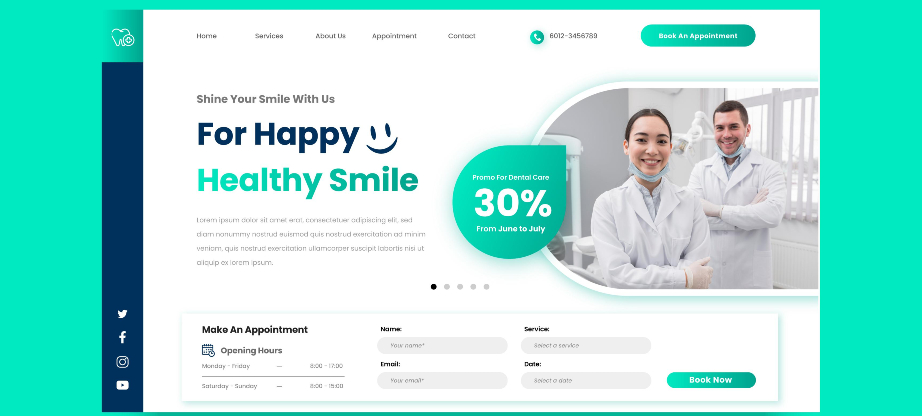Why is Dental Web Design So Different?
Web design for dental clinics includes clear factors that set it apart from other online layouts. These factors are critical to attracting potential patients, ensuring they are recognized, and complying with healthcare policies. Below, we’ll look at the key components that make dental web design specific and effective.
Patient-Centric Focus
At the core of dental web design is a patient-centric approach. The dental website templates should prioritize affected persons’ desires by supplying clean and accessible records about services, approaches, and patient care. This involves designing an intuitive layout that allows patients to find the information they need without difficulty, whether about a particular remedy or a well-known dental care recommendation. Ensuring the site is easy to navigate helps enhance the general user’s enjoyment and encourages sufferers to explore the offered offerings.
One of the primary features of a dental website is to facilitate appointment scheduling. Integrating a smooth-to-use online reservation device is crucial. This function should permit patients to e-book appointments conveniently, view available time slots, and receive affirmation notifications. A seamless booking system improves patient satisfaction and facilitates the sanatorium’s ability to manipulate its appointments correctly.
Trust and Credibility
Building trust is critical in healthcare, and dental websites gain this by emphasizing affected persons’ testimonials, certifications, and credentials. Displaying great snapshots and videos of the hospital, team of workers, and offerings can also help construct credibility. Short-form motion pictures, frequently under 30 seconds, are becoming increasingly popular. These films can explain remedies or share affected person testimonials, enhancing engagement and belief.
Another crucial issue is providing educational sources. Dental websites must provide complete statistics on dental fitness, processes, and preventative care. This enables and engages sufferers to make informed decisions about their dental care. Educational content, such as blogs, articles, movies, and infographics, can take up a lot of bureaucracy.
SEO for Local Search
Optimizing for nearby search is crucial to draw sufferers within the health facility’s area. This involves using neighborhood search engine optimization techniques to ensure that the website appears in search results while ability patients look for nearby dental offerings. Effective neighborhood search engine marketing includes optimizing the website’s content, meta descriptions, and key phrases and ensuring that the health facility’s name, deal with, and phone range (NAP) are regular throughout all online platforms.
Focusing on search engine marketing and retaining a sturdy online presence is essential for dental practices. Optimizing the internet site for search engines and using social media to sell the exercise enables the sanatorium to be made without problems observed by capability sufferers. Effective online advertising strategies can pressure site visitors to visit the website and boost affected persons’ inquiries and bookings.
Dental websites must follow healthcare guidelines, including the Data Protection Act 2018 and GDPR, to guard patient information. This involves implementing stringent data safety measures and making sure that everyone marketing sports is transparent and stable. Compliance with these policies is vital for keeping affected persons informed and averting criminal issues.
Simplified App-Style Layouts
A current fashion in dental internet design is the adoption of simplified app-style layouts. These layouts streamline the consumer experience, making it less difficult for patients to navigate the website online and quickly discover the data they need. This layout technique is mainly effective in improving cellular optimization, which is increasingly critical as extra sufferers access websites through mobile gadgets.
Incorporating lead magnet systems on dental websites is a powerful strategy for shooting capability sufferers’ touch facts. Clear calls to action (CTAs) are essential, guiding traffic to take particular movements, reserving an appointment, or contacting the sanatorium. Effective CTAs are outstanding and easy, making sure that sufferers can without difficulty comply with through.
Information Architecture and Quality of Content
The records architecture of dental websites has to be delicate to make it smooth for patients to find the statistics they want. Organizing content material logically and intuitively complements usability. Additionally, the exceptional content material is paramount. Ensuring that the content material is coherent, grammatically accurate, and free from spelling mistakes allows for maintaining professionalism and reliability.
The design and aesthetics of a dental website are vital for developing a tremendous first impression. This includes appealing visuals, a smooth format, and a cohesive color scheme. A well-designed website reflects the first-rate care provided by the sanatorium and helps attract and retain patients.
Patient Engagement and Mobile Optimization
Engaging patients through interactive elements and customized content can enhance their experience. With the growing use of cell gadgets, ensuring dental websites are optimized for cell viewing is vital. A responsive design that adapts to unique screen sizes and maintains usability on mobile devices is crucial for attaining a broader target audience.
Dental web design entails a mixture of affected person-centric capabilities, effective search engine optimization techniques, and compliance with regulatory standards. Dental clinics can create attractive, truthful, and user-friendly websites that entice and preserve sufferers by specializing in these factors. The ongoing technological improvements and evolving customer behaviors will continue to shape the future of dental net design, making it an exciting and dynamic field.


